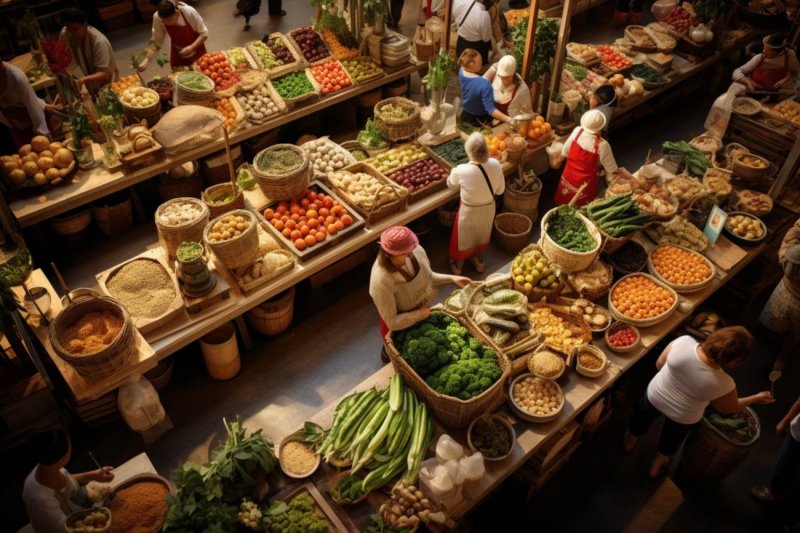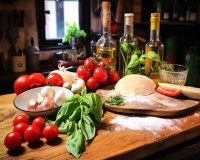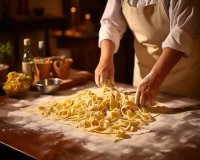Integrating Fresh Italian Produce in Cooking

From Market to Plate: Integrating Fresh Produce in Italian Cooking in Rome
When you think of Italian cuisine, the first images that come to mind may be of sumptuous pasta dishes, wood-fired pizzas, and delectable gelato. However, one cannot truly experience the essence of Italian cooking without exploring the vibrant markets of Rome, where fresh produce plays a starring role in the creation of mouthwatering dishes.
Rome, the eternal city, is a paradise for food enthusiasts. Its markets are a treasure trove of fresh, seasonal ingredients that form the backbone of traditional Italian recipes. Let's embark on a culinary journey to discover how fresh produce is seamlessly integrated into the heart of Roman cuisine.
The Mercato di Campo de' Fiori
If you find yourself in Rome, a visit to the Mercato di Campo de' Fiori is a must. This bustling market, located in the historic center of the city, is a kaleidoscope of colors and aromas. Stroll through the market's stalls and you'll encounter a symphony of fresh vegetables, fruits, herbs, and more. From plump, sun-ripened tomatoes to fragrant basil leaves, these are the building blocks of Italian cuisine.
The market vendors are not just purveyors of produce; they are keepers of tradition. They know the stories behind each ingredient and can guide you in choosing the best produce for your culinary adventures.
La Cucina Romana: The Roman Kitchen
Roman cuisine is characterized by its simplicity and reliance on fresh, high-quality ingredients. One of the most famous Roman dishes, the classic Spaghetti alla Carbonara, exemplifies this perfectly. It calls for just a handful of ingredients: pasta, eggs, Pecorino Romano cheese, pancetta, and black pepper. The star of the show? The eggs and cheese, creating a creamy and decadent sauce.
Another Roman specialty is the Cacio e Pepe, a pasta dish that features only three ingredients: Pecorino Romano cheese, black pepper, and pasta. The secret to its success lies in the quality of the cheese and the freshness of the pepper. This dish proves that simplicity can be utterly sublime when using top-notch produce.
The Roman Triad: Tomatoes, Basil, and Mozzarella
When it comes to fresh produce, the combination of tomatoes, basil, and mozzarella is a marriage made in culinary heaven. These ingredients are the core components of the famous Caprese salad. Luscious tomatoes, fragrant basil, and creamy mozzarella di bufala create a harmonious medley of flavors that transport your taste buds straight to Italy.
Moreover, these ingredients are also the backbone of one of Italy's most beloved dishes: pizza. A classic Margherita pizza showcases the red, green, and white of the Italian flag, thanks to the vibrant tomato sauce, basil leaves, and melted mozzarella. The success of this iconic pizza hinges on the freshness and quality of these components.
Seasonal Delights: Fresh Produce All Year Round
Rome's culinary culture is deeply rooted in the seasons. Different times of the year bring their own unique produce, inspiring seasonal dishes. In the spring, artichokes take center stage, with the famous Carciofi alla Romana being a local delicacy. In summer, you'll find fragrant peaches and figs, ideal for sweet treats or refreshing salads.
As autumn approaches, the city's markets brim with pumpkins and porcini mushrooms, perfect for hearty, earthy dishes. And when winter sets in, Roman cuisine turns to hearty greens, like cavolo nero, to create warming soups and stews.
In Conclusion
Italian cooking in Rome is a beautiful dance of fresh produce, tradition, and simplicity. It's a cuisine that cherishes the inherent flavors of quality ingredients and allows them to shine. Whether you're savoring a simple pasta dish or indulging in a multi-course feast, the markets of Rome play a vital role in creating the culinary magic that is Italian cooking.
So, when in Rome, don't miss the chance to explore the markets, savor the seasonal delights, and experience the authentic taste of Italian cuisine, from market to plate.
Rome: 3-in-1 Fettuccine, Ravioli, and Tiramisu Cooking Class
Learn how to prepare some of Italy's most famous pasta dishes as well as a traditional Italian dessert at a workshop in the heart of Rome.
About this activity
Impress your friends back home by learning how to prepare delicious Italian pasta and tiramisu during your time in Rome.
Start your lesson by learning how to make a delicious tiramisu before proceeding to make two types of pasta, ravioli, and fettuccine, from scratch.
Master the art of preparing the perfect pasta dough and learn which fillings are best for each season from your expert chef teacher.
In the second half of the workshop, sit down to enjoy the fruits of your labor with a glass of wine very close to Piazza Navona.
You will have the opportunity to taste your 2 pasta dishes, served with your choice of sauce and finished off with a plate of tiramisu.
Includes
- Cooking class
- Fettucine with chosen sauce
- Ravioli with butter and sage
- Tiramisu
- Glass of wine or soft drink
- Glass of Limoncello or coffee
- Water
Meeting point
Meet your chef inside the Restaurant Gusto, Piazza di Sant'Apollinare 41
The History of Italian Markets in Rome
Rome, the eternal city, is not only famous for its rich history and iconic landmarks, but also for its vibrant and diverse markets that have been an integral part of the city's culture for centuries. These markets offer a unique window into the daily life, traditions, and culinary delights of Italy. Let's take a journey through the history of Italian markets in Rome.
Historically, markets have been at the heart of Roman life, dating back to ancient times. The roots of these markets can be traced to the Forum Boarium, an ancient cattle market that operated as early as the 4th century BC. This was a place where merchants from all over the Mediterranean would gather to trade their goods, making it a bustling hub of commerce.
During the Roman Empire, the markets of Rome evolved and expanded. The Forum Romanum, for example, became a center of trade where people from all walks of life could purchase various goods, from food to textiles. The markets were not only places of commerce but also served as social and cultural hubs where Romans would gather to exchange news, stories, and ideas.
One of the most iconic markets in ancient Rome was the Trajan's Market, constructed around 100 AD. This multi-level market complex was not only a place for buying and selling but also a center for administrative and cultural activities. It housed over 150 shops and offices and featured a library and an auditorium. This historical site still stands today and gives us a glimpse into the sophistication of Roman markets.
As time passed, the markets in Rome continued to flourish. In the Middle Ages, the Campo de' Fiori market became known for its fresh produce, flowers, and local products. This market, which started in the 15th century, still operates today and is a popular spot for tourists and locals alike.
Trastevere, one of Rome's most picturesque neighborhoods, also has its own market history. The Porta Portese market, established in the 1940s, is a famous open-air flea market where you can find antiques, vintage items, and all sorts of curiosities.
Today, Rome boasts a wide variety of markets that cater to different tastes and preferences. The Testaccio Market, for example, is a food lover's paradise, offering fresh and local ingredients for traditional Italian recipes. The Mercato Monti, on the other hand, is a trendy market where you can find unique fashion and handcrafted goods.
One cannot discuss Italian markets without mentioning the Mercato di Campagna Amica. This market focuses on organic and sustainable products, showcasing the shift towards eco-conscious consumerism in the 21st century.
The history of Italian markets in Rome is a testament to the enduring nature of these institutions. They have evolved and adapted to the changing times, always remaining an essential part of Roman life. Whether you're looking for a taste of traditional Roman cuisine, a piece of history, or a unique souvenir, Rome's markets have something to offer everyone.
In conclusion, the markets of Rome have a rich and storied history that dates back thousands of years. From the bustling markets of ancient Rome to the diverse and vibrant markets of today, they have always played a significant role in the daily life of the city. So, when you visit Rome, don't forget to explore these markets to experience the essence of the Eternal City.
Spritz and Spaghetti Traditional Cooking Class in Rome
Unleash your inner chef in Rome with the Spritz and Spaghetti Traditional Cooking Class. Hosted by Tipsy Tours, this unique experience combines the art of Italian mixology and pasta making, offering you a delightful and tipsy culinary adventure.
During this 3-hour workshop, you'll have the opportunity to learn the secrets behind creating three authentic Italian cocktails, including the iconic Aperol Spritz. Dive into the heart of Italian cuisine as you master the art of making classic pasta dishes, with a focus on the perfect Carbonara. Vegetarians can indulge in the vegetarian option of Caccio Peppe, ensuring a delightful experience for everyone.
What sets this cooking class apart is its fusion of Italian traditions with a tipsy twist. Enjoy a lively atmosphere as you engage in mixology lessons and pasta preparation with the chef. Cocktails with the chef add an extra layer of excitement to the event, making it a one-of-a-kind experience in Rome.
This workshop promises a unique blend of fun, learning, and culinary indulgence. Whether you're a cooking enthusiast or just looking for a memorable experience in Rome, the Spritz and Spaghetti Traditional Cooking Class is a must-try adventure.
Book your spot now and embark on a journey to discover the art of Italian cocktails and pasta making like never before.
Activity Provider: Tipsy Tours
Meeting Point: Check availability for details
Language: Live tour guide in English
Duration: 3 hours
Highlights:
- Learn to create three Italian Cocktails, including the Aperol Spritz
- Master the art of making classic Italian pasta, with a focus on Carbonara and a vegetarian option of Caccio Peppe
- Enjoy a unique tipsy experience with cocktails and pasta preparation led by the chef
- Engage in mixology lessons and learn the secrets behind Italian cocktails
This is not your ordinary cooking class in Rome. Don't miss the chance to add a delightful and tipsy twist to your culinary skills. Reserve your spot now and get ready for an unforgettable adventure in the heart of Italian cuisine.
The Benefits of Fresh Ingredients
Fresh ingredients are the cornerstone of any delicious meal. Whether you're a seasoned chef or a novice in the kitchen, the quality of the ingredients you use can make or break a dish. In this article, we'll explore the numerous benefits of using fresh ingredients in your cooking.
1. Superior Flavor
One of the most significant advantages of using fresh ingredients is the unparalleled flavor they bring to your dishes. Fresh fruits, vegetables, herbs, and meats are bursting with natural flavors that can't be replicated by their processed or frozen counterparts. The taste of a ripe, juicy tomato or a freshly picked herb is simply incomparable.
2. Nutrient-Rich
Fresh ingredients are packed with essential nutrients that are vital for your health. When you use fresh produce, you're getting the maximum vitamins, minerals, and antioxidants your body needs. In contrast, canned or frozen items often lose some of their nutritional value during processing.
3. Improved Texture
Fresh ingredients also offer superior texture. Crisp, crunchy vegetables, tender cuts of meat, and perfectly ripe fruits add depth and variety to your dishes. The textures of fresh ingredients enhance the overall dining experience, making your meals more enjoyable.
4. Variety and Seasonality
Using fresh ingredients allows you to embrace the changing seasons and enjoy a diverse range of foods throughout the year. Seasonal produce not only tastes better but is often more affordable, as it doesn't need to be transported long distances. You can create exciting menus that evolve with the seasons, keeping your culinary adventures fresh and exciting.
5. Supporting Local Agriculture
When you choose fresh ingredients, you're also supporting local farmers and producers. Buying locally grown or sourced products boosts your community's economy and reduces the environmental impact of food transportation. It's a win-win for both your taste buds and the planet.
6. Fewer Additives
Processed and packaged foods often contain a multitude of additives, preservatives, and artificial flavors. When you opt for fresh ingredients, you have more control over what goes into your meals. This helps you avoid unnecessary chemicals and ensures a healthier diet for you and your family.
7. Culinary Creativity
Fresh ingredients inspire culinary creativity. As you explore local markets or your garden, you'll come across new ingredients and flavors that spark your imagination. Fresh, seasonal ingredients invite you to experiment with different recipes and cooking techniques, expanding your culinary horizons.
8. Reduced Food Waste
Using fresh ingredients often leads to less food waste. You can buy just the amount you need and avoid items languishing in the back of your pantry or freezer. This not only saves money but also helps reduce the amount of food that ends up in landfills.
9. Unforgettable Dining Experiences
Ultimately, the use of fresh ingredients elevates your dining experiences. Whether you're cooking for yourself, your family, or hosting a dinner party, fresh ingredients create memorable meals that leave a lasting impression on your guests.
In conclusion, the benefits of using fresh ingredients in your cooking are vast and varied. From superior flavor and nutrition to supporting local agriculture and reducing food waste, fresh ingredients enhance your culinary journey in numerous ways. So, the next time you're in the kitchen, remember that fresh is best!







